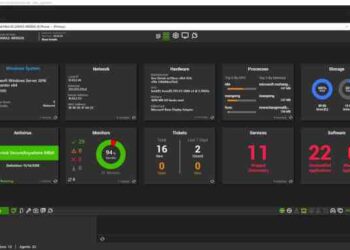Exploring the important features to look for in RMM solutions unveils a realm of crucial functionalities that drive effective IT infrastructure management. Delve into this guide with a blend of insightful details and practical advice for a rewarding read.
In the subsequent paragraphs, we will elaborate on each key feature, shedding light on their significance and impact.
Key Features Overview
RMM solutions, or Remote Monitoring and Management solutions, play a crucial role in managing IT infrastructure efficiently. These solutions are designed to provide a centralized platform for monitoring, managing, and maintaining various aspects of an organization's IT systems.
Automated Monitoring and Alerts
One of the primary functions of RMM solutions is automated monitoring of servers, workstations, network devices, and applications. These solutions continuously track the performance and health of IT assets and generate alerts in real-time in case of any issues or anomalies.
Remote Control and Management
RMM solutions allow IT administrators to remotely access and manage devices and systems from a single dashboard. This feature enables efficient troubleshooting, software updates, and system configurations without the need for physical presence at the location.
Patch Management
Effective patch management is essential for keeping systems secure and up to date. RMM solutions automate the patching process by deploying updates across the network, ensuring that vulnerabilities are addressed promptly to prevent security breaches.
Asset Inventory and Tracking
Keeping track of hardware and software assets is crucial for IT asset management. RMM solutions provide detailed asset inventory reports, including hardware specifications, software licenses, and warranty information, helping organizations maintain accurate records and plan for upgrades effectively.
Performance Monitoring and Reporting
RMM solutions offer performance monitoring tools that track key metrics such as CPU usage, memory utilization, disk space, and network bandwidth. By analyzing this data and generating comprehensive reports, IT teams can identify trends, optimize resource allocation, and proactively address performance issues.
Monitoring Capabilities
Real-time monitoring is a crucial feature in RMM solutions as it allows businesses to track the performance of their networks and devices continuously. By providing real-time updates on system health, network traffic, and potential security threats, monitoring capabilities help organizations proactively address issues before they escalate.
Types of Monitoring Tools in RMM Solutions
- Agent-Based Monitoring: Utilizes software agents installed on each device to collect data and report back to the central management console.
- Agentless Monitoring: Monitors devices without the need for additional software installations, reducing resource consumption on endpoints.
- Synthetic Transaction Monitoring: Simulates user interactions with applications to detect performance issues from an end-user perspective.
Impact of Monitoring Capabilities on Network Performance and Security
Monitoring capabilities play a critical role in ensuring optimal network performance and security. By continuously monitoring key metrics such as bandwidth usage, device health, and security vulnerabilities, organizations can identify and address potential issues in real-time. This proactive approach helps prevent network downtime, optimize resource utilization, and enhance overall security posture.
Automation and Scripting
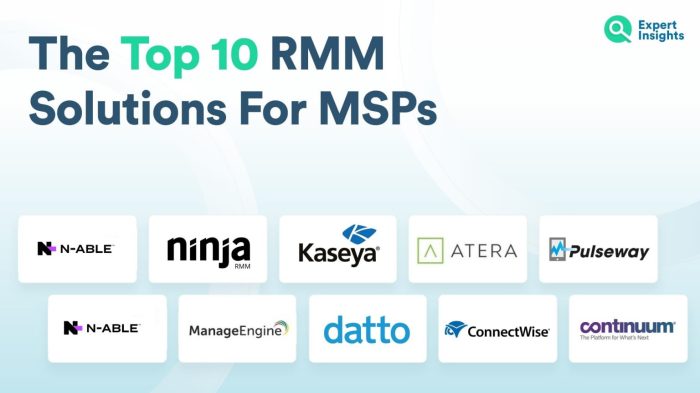
Automation plays a crucial role in Remote Monitoring and Management (RMM) solutions by enabling IT professionals to streamline and optimize their workflow. By automating routine tasks, organizations can increase efficiency, reduce human error, and free up valuable time for more strategic initiatives.
Benefits of Scripting for Automation
Scripting allows IT administrators to create customized scripts to automate repetitive tasks across multiple devices or systems. This not only saves time but also ensures consistency and accuracy in the execution of these tasks. Some benefits of scripting in RMM solutions include:
- Automating software updates and patch management
- Performing regular system maintenance tasks
- Generating reports and alerts based on specific conditions
- Deploying configurations or settings to multiple endpoints
Patch Management
Patch management is a critical aspect of Remote Monitoring and Management (RMM) solutions as it plays a vital role in ensuring the security and stability of systems. By regularly applying patches and updates to software and operating systems, organizations can mitigate vulnerabilities and reduce the risk of cyber attacks.
Patch Deployment and Updates
RMM solutions streamline the patch management process by automating the deployment of updates across all endpoints within a network. These solutions provide centralized control and visibility, allowing IT teams to schedule, prioritize, and monitor patch deployments effectively. They also offer features such as testing environments and rollback capabilities to ensure that patches do not cause any disruptions or conflicts within the system.
- RMM solutions can automatically scan endpoints for missing patches and updates, ensuring that systems are up to date with the latest security fixes.
- Automated patch deployment reduces manual intervention, saving time and resources for IT teams while improving overall system security.
- Regular patching helps in closing known security vulnerabilities, reducing the risk of malware infections, data breaches, and other cyber threats.
- By maintaining a consistent patch management process, organizations can comply with industry regulations and standards that require systems to be regularly updated and secured.
Impact on System Security
Effective patch management has a direct impact on system security by strengthening the overall defense against cyber threats. By keeping software and systems up to date, organizations can significantly reduce the attack surface and minimize the risk of exploitation by cybercriminals
Timely patching also helps in maintaining system performance and reliability, ensuring that critical business operations run smoothly without interruptions.
“Patch management is not just about fixing bugs; it’s about safeguarding your organization against cyber threats and ensuring the continuity of business operations.”
Remote Access and Control
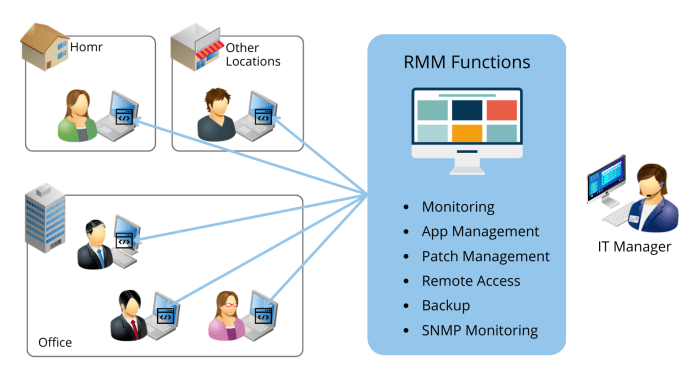
When it comes to Remote Monitoring and Management (RMM) solutions, remote access and control are essential features that can greatly benefit IT professionals. These features allow IT teams to remotely access and manage devices, troubleshoot issues, and provide support without being physically present at the location of the device.
Remote Access Features
Remote access features offered by RMM solutions typically include the ability to remotely connect to devices, view the desktop interface, transfer files, and execute commands. This allows IT teams to troubleshoot issues, install software updates, and perform maintenance tasks without the need for on-site visits.
- Remote Desktop Connection: IT professionals can access the desktop interface of a remote device to diagnose and resolve issues.
- File Transfer: Allows for the seamless transfer of files between the IT professional's device and the remote device.
- Command Execution: Enables IT teams to run commands on the remote device to perform tasks or configurations.
Security Considerations
When enabling remote access, security considerations are paramount to protect sensitive data and prevent unauthorized access. It is crucial to implement strong authentication methods, encryption protocols, and access controls to ensure the security of remote connections.
Implementing multi-factor authentication and using encrypted connections, such as SSL/TLS, can help secure remote access.
Enhanced IT Support and Troubleshooting
Remote control capabilities offered by RMM solutions enhance IT support and troubleshooting processes by enabling IT teams to quickly respond to issues, resolve problems efficiently, and minimize downtime. With remote access and control, IT professionals can provide real-time support to end-users, regardless of their location, leading to improved productivity and customer satisfaction.
Reporting and Analytics
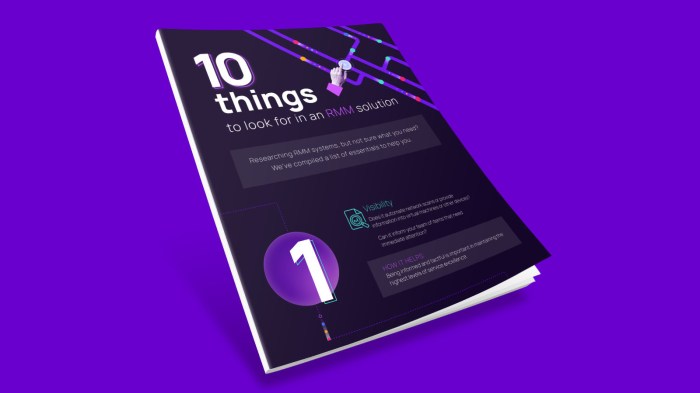
Reporting and analytics play a crucial role in RMM solutions as they provide valuable insights into the performance and health of IT systems. By collecting and analyzing data, reporting and analytics help organizations make informed decisions and optimize their operations.
Types of Analytics in RMM Solutions
- Performance Analytics: Monitor the performance of devices and networks to identify bottlenecks or issues affecting efficiency.
- Security Analytics: Detect and respond to security threats by analyzing patterns and anomalies in network traffic and system behavior.
- Compliance Analytics: Ensure that IT systems adhere to industry regulations and internal policies through continuous monitoring and reporting.
Role of Reporting in RMM Solutions
Reporting in RMM solutions enables IT administrators to track key metrics, such as uptime, response times, and resource utilization. These reports provide a comprehensive view of the IT environment, allowing for proactive maintenance and troubleshooting.
Benefits of Reporting and Analytics
- Decision-Making: Data-driven insights from reporting and analytics help organizations make strategic decisions to improve IT performance and security.
- Performance Optimization: By identifying trends and patterns through analytics, organizations can optimize their IT infrastructure for better efficiency and reliability.
- Proactive Maintenance: Reporting alerts IT teams to potential issues before they escalate, enabling proactive maintenance and minimizing downtime.
Final Thoughts
Conclusively, the discussion around important features to look for in RMM solutions encapsulates the essence of streamlined IT operations, emphasizing the pivotal role these features play in ensuring optimal performance and security.
Quick FAQs
What are the primary functions of RMM solutions?
RMM solutions primarily aim to monitor, manage, and maintain IT infrastructure remotely, ensuring efficient operations and enhanced security.
Why is real-time monitoring significant in RMM solutions?
Real-time monitoring provides immediate insights into network performance and security threats, enabling prompt responses to issues for uninterrupted operations.
How does patch management contribute to system security in RMM solutions?
Patch management ensures that software vulnerabilities are promptly addressed through timely updates, reducing the risk of cyber threats and enhancing overall system security.
What are the key remote access features in RMM solutions?
Remote access features in RMM solutions enable IT teams to access and troubleshoot devices and systems from any location, facilitating efficient support and maintenance tasks.
How do reporting and analytics aid in decision-making with RMM solutions?
Reporting and analytics provide valuable insights into IT performance metrics and trends, empowering informed decision-making for optimizing system operations and resource allocation.
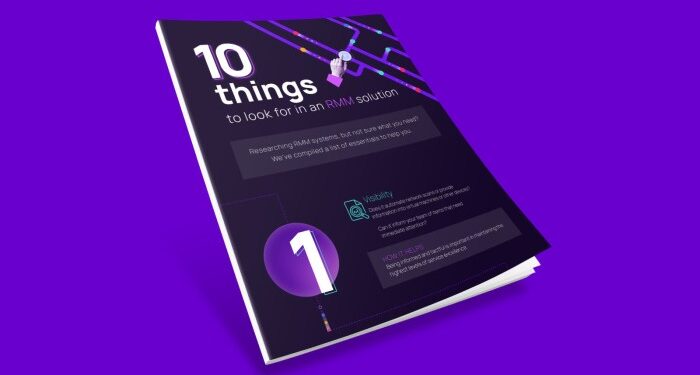




![Top 10 RMM Solutions [2024] | NinjaOne](https://ecommerce.mardinata.com/wp-content/uploads/2025/10/Best-RMM-Software-and-Tools-1-120x86.jpg)




